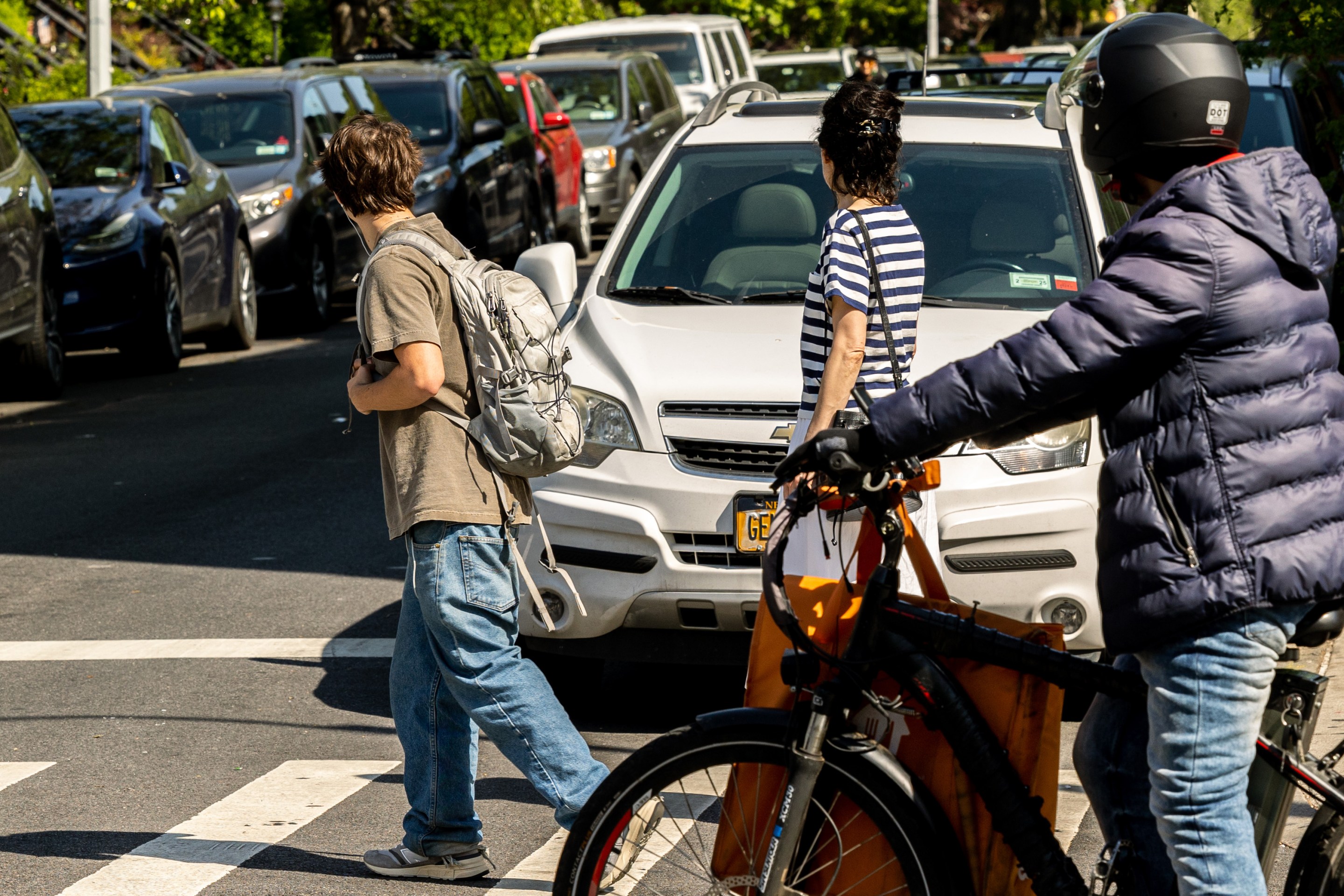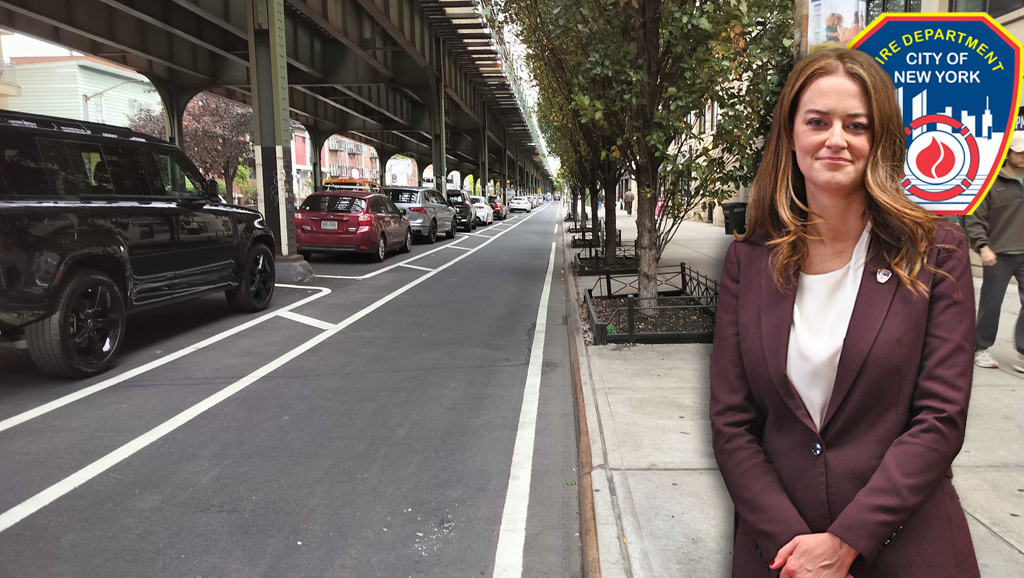
Four years ago, White Flint, a neighborhood of North Bethesda, Maryland, most known for its shopping mall, caught the attention of urbanists around the nation with a proposal to reimagine car-oriented suburban streets as a walkable, mixed-use, transit-oriented neighborhood. Montgomery County adopted a plan for the town that would narrow its wide arterial roadways and make them safe and accommodating for transit riders, bicyclists, and pedestrians. It was hailed as a model for other suburbs around the nation looking to become less sprawling and more walkable.
But now, the county is quietly trying to undo much of the good work in the 2010 plan -- namely, the street designs. The most recent design shared by the Montgomery County DOT showed a reversal of previous promises. Rather than bring Old Georgetown Road down from six car lanes to four, adding curbside bike lanes on each side as well as a bike/pedestrian path that fits into a larger trail loop, the new plan would actually make the road wider by adding turn lanes for motor vehicles. The bike lanes or shared-use path are scuttled as well.
Ramona Bell-Pearson, assistant chief administrative officer with the Montgomery County Executive, assured Streetsblog, "Everything that’s required in the master plan for Old Georgetown Road is what’s being designed." But the plan specifies that that segment of the street will be four lanes wide and have bike lanes and a shared-use path. Bell-Pearson wouldn't confirm that those elements will be in the final plan.
The county insists that the master plan is still under development and that the street design recently shared with stakeholders is far from final. Meanwhile, county and state officials say that the land use changes have to precede any overhaul of the streets. State Highway Administration studies say the wider configuration is still needed to avoid "Christmas-time traffic backup."
Andy Scott, director of the Maryland DOT's Office of Real Estate, grew up in nearby Rockville. He says a lot of White Flint still looks like it did in the eighties, when he was in high school, working at an Erol's video store in a strip mall on Old Georgetown Road. To grab a bite across the street, he had to traverse "acres of asphalt parking lot and cross a busy highway." He tried it on foot one time, and it was so unnatural he never did it again. The redevelopment will change all that.
Scott says the concern about Old Georgetown Road is just a "hiccup," a miscommunication in what's otherwise a visionary project. The streets will change, he says, but in a certain sequence. "There’s a balance in building out the transportation infrastructure and the development that’s going to shift people to walking, biking, transit ridership -- but it doesn’t happen overnight," Scott said. "It was carefully phased both on the development side and the transportation infrastructure side."

Stewart Schwartz of the DC-area’s Coalition for Smarter Growth contested the idea that street redesigns have to be put on hold. "The traffic engineers are nervous about the interim period," he said. "They don’t recognize that congestion always provides a feedback signal. If there’s congestion, people change the time of day of their commute; they change the mode of their commute; and you’re likely to see more transit riders. What this points to is the need to move faster in redesigning these places and incentivizing redevelopment."
The county says it always intended to do the redesign in "phases," but the phases described in the plan don’t involve two separate reconstructions of Old Georgetown Road, which Lindsay Hoffman of Friends of White Flint calls "an inefficient use of our tax dollars." In the plan, Phase One involves a certain amount of housing construction and commercial development and lists several prerequisites for proceeding to Phase Two, including: “Fund streetscape improvements, sidewalk improvements, and bikeways for substantially all of the street frontage within one quarter-mile of the Metro station: Old Georgetown Road, Marinelli Road, and Nicholson Lane."
It also states that the share of non-automotive trips in the area must grow from the current 25 percent to 34 percent before moving on to Phase Two.

As CSG's Kelly Blynn recently wrote at Greater Greater Washington, waiting for people to change travel habits before redesigning streets is a recipe for inaction. If the county now plans to consider the wider road “Phase One” and the four-lane design “Phase Two,” how is mode shift supposed to happen without substantial improvements to walking and biking infrastructure? It’s a Catch-22, says Schwartz. “You’ll never get to that mode share if you keep building roads that pedestrians are afraid to cross.”
Bell-Pearson of the County Executive’s office admitted that changing mode share without redesigning streets is “difficult.” But she said there’s a different chicken-and-egg problem: The changes in White Flint are financed, in large part, by a tax district that was voluntarily put together by the developers in the area. Until development happens, she said, there’s no tax revenue for infrastructure.
After three years and more than 200 public meetings to bring about a broad consensus for the White Flint plan, Hoffman is frustrated that the discussion of streets has landed back at square one. “You find yourself having to, again, talk about whether people are going to get out of their cars, and, ‘Do we build the infrastructure first?’” she said. “It’s like we’re having those same conversations all over again, when they went pretty well the first time.”
Montgomery Planning Board Chair Casey Anderson stressed the importance of aligning the street network with the vision in the master plan. "This is not just a question of making it easier and more attractive to walk or ride a bike," he said. "It’s about reorienting the way we design communities to make them more appealing places to live and work. If we don’t get this right it will make it much harder to achieve our economic development goals, because our competitive position depends on building high quality, livable places where people want to be.”
While White Flint is situated between the highly urban town centers of Rockville and Bethesda, and the state of Maryland is a leader in smart growth nationwide, MCDOT has historically lagged behind. Advocates don’t trust the agency. Some think MCDOT never really believed in the White Flint sector plan.
White Flint isn't the only high-profile suburban retrofit where public officials have balked at overhauling car-centric streets. In nearby Tysons Corner, the biggest suburban redevelopment project in the country, recent designs show road widenings that would jeopardize the supposed transition to a more livable, pedestrian-friendly environment.
But White Flint should be above all that, said Schwartz.
“Because the White Flint situation is taking place in one of the country’s wealthiest counties, and you have strong developer commitment to a smart growth solution there, along with community support, you have the perfect situation to create a winning case study,” Schwartz said.





